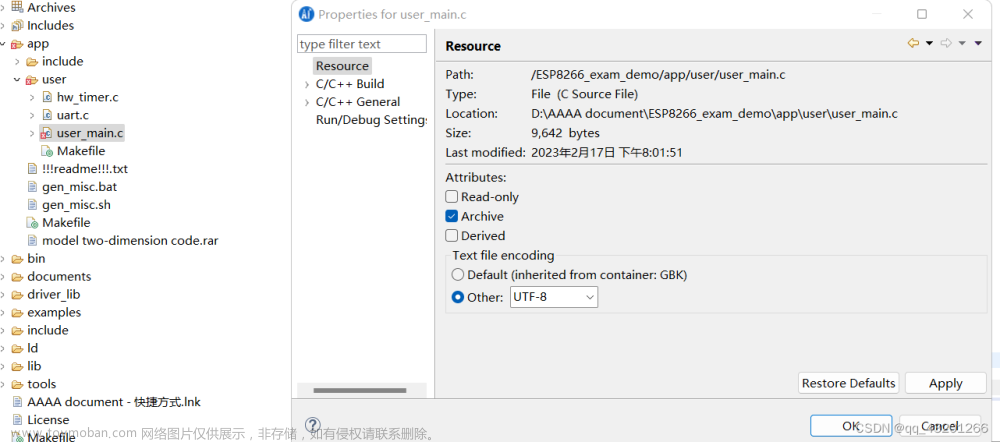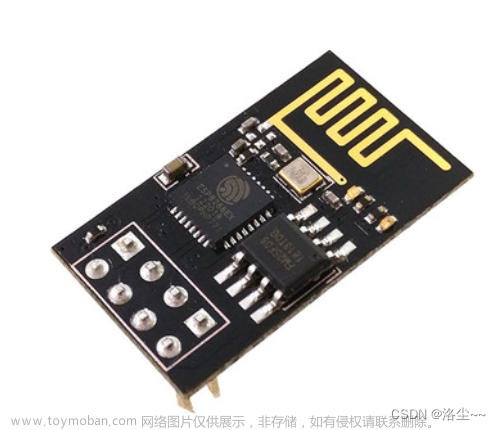一、实验内容。
定义两个串口,分别接收两个按键输入0、1,或接收PC发送的AT指令,两个输入,通过按键切换输入到esp8266,从而完成WiFi连接、TCP服务器连接、以及数据0、1发送。
二、系统架构。

三、RTL视图

四、项目代码。
uart_tx.v串口发送模块
// uart_tx.v
`include "param.v"
module uart_tx(
input wire clk ,
input wire rst_n ,
input wire tx_req,//发送请求
input wire [7:0] tx_din,//并行数据输入
output reg tx_dout,//串行数据输出
output wire dout_vld//并转串完成标志
);
reg [12:0] cnt_bps ;//波特率计数寄存器
wire add_cnt_bps ;//波特率计数开始
wire end_cnt_bps ;//波特率计数结束
reg [3:0] cnt_bit ;//比特计数寄存器
wire add_cnt_bit ;//比特计数开始
wire end_cnt_bit ;//比特计数结束
reg tx_flag ;//发送标志
reg [9:0] tx_data ;
//波特率计数器设计
always @(posedge clk or negedge rst_n)begin
if(!rst_n)begin
cnt_bps <= 13'd0;
end
else if(add_cnt_bps)begin
if(end_cnt_bps)begin
cnt_bps <= 13'd0;
end
else begin
cnt_bps <= cnt_bps + 1'd1;
end
end
else begin
cnt_bps <= cnt_bps;
end
end
assign add_cnt_bps = tx_flag;
assign end_cnt_bps = add_cnt_bps && cnt_bps == (`SYS_FRQ/`BAUD_MAX) - 1'd1;
always @(posedge clk or negedge rst_n)begin
if(!rst_n)begin
cnt_bit <= 4'd0;
end
else if(add_cnt_bit)begin
if(end_cnt_bit)begin
cnt_bit <= 4'd0;
end
else begin
cnt_bit <= cnt_bit + 1'd1;
end
end
else begin
cnt_bit <= cnt_bit;
end
end
assign add_cnt_bit = end_cnt_bps;
assign end_cnt_bit = add_cnt_bit && cnt_bit == 9;
//发送标志tx_flag
always @(posedge clk or negedge rst_n)begin
if(!rst_n)begin
tx_flag <= 1'b0;
end
else if(tx_req)begin
tx_flag <= 1'b1;
end
else if(end_cnt_bit)begin
tx_flag <= 1'b0;
end
else begin
tx_flag <= tx_flag;
end
end
//数据缓存,tx_data
always @(posedge clk or negedge rst_n)begin
if(!rst_n)begin
tx_data <= 10'b0;
end
else if(tx_req)begin
tx_data <= {1'b1, tx_din, 1'b0};
end
else begin
tx_data <= tx_data;
end
end
//tx_dout数据串行输出
always @(posedge clk or negedge rst_n)begin
if(!rst_n)begin
tx_dout <= 1'b1;
end
else if(tx_flag && cnt_bps == 1)begin
tx_dout <= tx_data[cnt_bit];
end
else begin
tx_dout <= tx_dout;
end
end
//dout_vld约束
assign dout_vld = ~tx_flag;
endmodule
uart_rx.v串口接收模块
`include "param.v"
module uart_rx(
input wire clk ,
input wire rst_n ,
input wire rx_din ,//串行数据输入
output wire [7:0] rx_dout ,//并行数据输出
output reg dout_vld//串转并完成标志
);
reg [12:0] cnt_bps ;//波特率计数寄存器
wire add_cnt_bps ;//波特率计数开始
wire end_cnt_bps ;//波特率计数结束
reg [3:0] cnt_bit ;//比特计数寄存器
wire add_cnt_bit ;//比特计数开始
wire end_cnt_bit ;//比特计数结束
reg rx_din_r0;//同步
reg rx_din_r1;//打拍
wire nedge ;//下降沿
reg rx_flag;//接受标志
reg [9:0] rx_data;//寄存数据包
//波特率计数器设计
always @(posedge clk or negedge rst_n)begin
if(!rst_n)begin
cnt_bps <= 13'd0;
end
else if(add_cnt_bps)begin
if(end_cnt_bps)begin
cnt_bps <= 13'd0;
end
else begin
cnt_bps <= cnt_bps + 1'd1;
end
end
else begin
cnt_bps <= cnt_bps;
end
end
assign add_cnt_bps = rx_flag;
assign end_cnt_bps = add_cnt_bps && cnt_bps == (`SYS_FRQ / `BAUD_MAX) - 1'd1;
//比特计数器设计
always @(posedge clk or negedge rst_n)begin
if(!rst_n)begin
cnt_bit <= 4'd0;
end
else if(add_cnt_bit)begin
if(end_cnt_bit)begin
cnt_bit <= 4'd0;
end
else begin
cnt_bit <= cnt_bit + 1'd1;
end
end
else begin
cnt_bit <= cnt_bit;
end
end
assign add_cnt_bit = end_cnt_bps;
assign end_cnt_bit = add_cnt_bit && cnt_bit == 4'd10 - 1'd1;
//起始位位置检测
always @(posedge clk or negedge rst_n)begin
if(!rst_n)begin
rx_din_r0 <= 1'b1;
rx_din_r1 <= 1'b1;
end
else begin
rx_din_r0 <= rx_din;
rx_din_r1 <= rx_din_r0;
end
end
assign nedge = ~rx_din_r0 && rx_din_r1;
//接受标志rx_flag约束
always @(posedge clk or negedge rst_n)begin
if(!rst_n)begin
rx_flag <= 1'b0;
end
else if(nedge)begin
rx_flag <= 1'b1;
end
else if(end_cnt_bit)begin
rx_flag <= 1'b0;
end
else begin
rx_flag <= rx_flag;
end
end
//缓存接受到的数据
always @(posedge clk or negedge rst_n)begin
if(!rst_n)begin
rx_data <= 10'b0;
end
else if(rx_flag && cnt_bps == (`SYS_FRQ/`BAUD_MAX) >> 1)begin
rx_data[cnt_bit] = rx_din_r0;
end
else begin
rx_data <= rx_data;
end
end
assign rx_dout = rx_data[8:1];
//串转并完成标志dout_vld约束
always @(posedge clk or negedge rst_n)begin
if(!rst_n)begin
dout_vld <= 1'b0;
end
else if(end_cnt_bit)begin
dout_vld <= 1'b1;
end
else begin
dout_vld <= 1'b0;
end
end
endmodule
param.v波特率常量定义
`define SYS_FRQ 50_000_000
`define BAUD_115200
`ifdef BAUD_9600
`define BAUD_MAX 9600
`elsif BAUD_19200
`define BAUD_MAX 19200
`elsif BAUD_38400
`define BAUD_MAX 38400
`elsif BAUD_57600
`define BAUD_MAX 57600
`elsif BAUD_115200
`define BAUD_MAX 115200
`else
`define BAUD_MAX 9600
`endif
key_debounce.v按键消抖模块
module key_debounce(
input clk,
input rst_n,
input key,
output reg temp
);
parameter DELAY = 20'd1000_000;
reg [19:0] delay_cnt;
reg key_reg;//保存上一时刻的键值
reg flag,key_value;
always @(posedge clk or negedge rst_n) begin
if(!rst_n)begin
delay_cnt <= 20'd0;
key_reg <= 1'b1;
end
else begin
key_reg <= key;
if(key_reg != key)begin
delay_cnt <= DELAY;
end
else begin
if(delay_cnt > 20'd0)begin
delay_cnt <= delay_cnt - 1'd1;
end
else begin
delay_cnt <= 20'd0;
end
end
end
end
always @(posedge clk or negedge rst_n) begin
if(!rst_n)begin
flag <= 1'b0;
key_value <= 1'b1;
end
else if(delay_cnt == 1'd1)begin
flag <= 1'b1;
key_value <= key;
end
else begin
flag <= 1'b0;
key_value <= key_value;
end
end
always @(posedge clk or negedge rst_n) begin
if(!rst_n)begin
temp <= 1'b0;
end
else begin
if(flag&&~key_value)begin
temp <= 1'b1;
end
else
temp <= 1'b0;
end
end
endmodule
date_send.v数据发送模块
`include "param.v"
module date_send(
input wire clk ,
input wire rst_n ,
input wire [1:0] key,
output reg tx_dout//串行数据输出
);
reg tx_req;//发送请求
reg [7:0] tx_din;//并行数据输入
reg [12:0] cnt_bps ;//波特率计数寄存器
wire add_cnt_bps ;//波特率计数开始
wire end_cnt_bps ;//波特率计数结束
reg [3:0] cnt_bit ;//比特计数寄存器
wire add_cnt_bit ;//比特计数开始
wire end_cnt_bit ;//比特计数结束
reg tx_flag ;//发送标志
reg [9:0] tx_data ;
always @(posedge clk or negedge rst_n)begin
if(!rst_n)begin
tx_req <= 0;
tx_din <= 0;
end
else if(key[0]&&!key[1])begin
tx_req <= 1;
tx_din <= 8'd48;
end
else if(key[1]&&!key[0])begin
tx_req <= 1;
tx_din <= 8'd49;
end
else begin
tx_req <= 0;
end
end
//波特率计数器设计
always @(posedge clk or negedge rst_n)begin
if(!rst_n)begin
cnt_bps <= 13'd0;
end
else if(add_cnt_bps)begin
if(end_cnt_bps)begin
cnt_bps <= 13'd0;
end
else begin
cnt_bps <= cnt_bps + 1'd1;
end
end
else begin
cnt_bps <= cnt_bps;
end
end
assign add_cnt_bps = tx_flag;
assign end_cnt_bps = add_cnt_bps && cnt_bps == (`SYS_FRQ/`BAUD_MAX) - 1'd1;
always @(posedge clk or negedge rst_n)begin
if(!rst_n)begin
cnt_bit <= 4'd0;
end
else if(add_cnt_bit)begin
if(end_cnt_bit)begin
cnt_bit <= 4'd0;
end
else begin
cnt_bit <= cnt_bit + 1'd1;
end
end
else begin
cnt_bit <= cnt_bit;
end
end
assign add_cnt_bit = end_cnt_bps;
assign end_cnt_bit = add_cnt_bit && cnt_bit == 9;
//发送标志tx_flag
always @(posedge clk or negedge rst_n)begin
if(!rst_n)begin
tx_flag <= 1'b0;
end
else if(tx_req)begin
tx_flag <= 1'b1;
end
else if(end_cnt_bit)begin
tx_flag <= 1'b0;
end
else begin
tx_flag <= tx_flag;
end
end
//数据缓存,tx_data
always @(posedge clk or negedge rst_n)begin
if(!rst_n)begin
tx_data <= 10'b0;
end
else if(tx_req)begin
tx_data <= {1'b1, tx_din, 1'b0};
end
else begin
tx_data <= tx_data;
end
end
//tx_dout数据串行输出
always @(posedge clk or negedge rst_n)begin
if(!rst_n)begin
tx_dout <= 1'b1;
end
else if(tx_flag && cnt_bps == 1)begin
tx_dout <= tx_data[cnt_bit];
end
else begin
tx_dout <= tx_dout;
end
end
//dout_vld约束
assign dout_vld = ~tx_flag;
endmodule
uart.v顶层模块
module uart(
input wire clk ,
input wire rst_n ,
input [2:0] key ,
input wire rx_esp,
output wire tx_esp, //串行输出
input wire rx_pc,
output wire tx_pc //串行输出
);
wire [7:0] rx_byte ;
wire rx_byte_vld ;
wire [7:0] rx_byte1 ;
wire rx_byte_vld1 ;
wire [2:0] temp ;
wire tx_AT ;
wire tx_data ;
reg en;
assign tx_esp=en==1?tx_AT:tx_data;
always @(posedge clk or negedge rst_n)begin
if(!rst_n)begin
en <= 0;
end
else if(temp[0])begin
en <= ~en;
end
else begin
en <= en;
end
end
key_debounce(
.clk(clk),
.rst_n(rst_n),
.key(key[0]),
.temp(temp[0])
);
key_debounce(
.clk(clk),
.rst_n(rst_n),
.key(key[1]),
.temp(temp[1])
);
key_debounce(
.clk(clk),
.rst_n(rst_n),
.key(key[2]),
.temp(temp[2])
);
uart_rx u_uart_rx(
.clk (clk),
.rst_n (rst_n),
.rx_din (rx_pc),//串行数据输入
.rx_dout (rx_byte),//并行数据输出
.dout_vld(rx_byte_vld)//串转并完成标志
);
uart_rx u_uart_rx1(
.clk (clk),
.rst_n (rst_n),
.rx_din (rx_esp),//串行数据输入
.rx_dout (rx_byte1),//并行数据输出
.dout_vld(rx_byte_vld1)//串转并完成标志
);
uart_tx u_uart_tx(
.clk (clk),
.rst_n (rst_n),
.tx_req(rx_byte_vld),//发送请求
.tx_din(rx_byte),//并行数据输入
.tx_dout(tx_AT)//串行数据输出
//.dout_vld()//并转串完成标志
);
date_send u_date_send(
.clk (clk),
.rst_n (rst_n),
.key (temp[2:1]),
.tx_dout(tx_data)//串行数据输出
);
uart_tx u_uart_tx1(
.clk (clk),
.rst_n (rst_n),
.tx_req(rx_byte_vld1),//发送请求
.tx_din(rx_byte1),//并行数据输入
.tx_dout(tx_pc)//串行数据输出
//.dout_vld()//并转串完成标志
);
endmodule
五、具体操作及运行结果。
1.按照管教分配连接ESP8266.
2.连接WiFi
按下key1,将串口tx端切换到PC,此时可接收来自串口调试助手的数据。
在串口调试助手中选择开发板端口,并打开串口。
输入 AT+RST 重启ESP8266模块。
输入 AT+CWMODE=1 将模块设置为Station模式。(可能会因编码原因返回乱码)
输入 AT+CWJAP=“SSID”,“PWD” 该命令为连接路由器发出的WiFi信号,SSID为此WiFi的用户名,PWD为此PWD的密码。如果返回乱码,可在路由器后台,或电脑热点设置中查看是否连接成功。
在热点设置中查看到,esp8266连接成功。
3.创建TCP服务器
打开Socket tool,并创建端口为6666的TCP服务器。
打开串口调试助手,输入并发送指令:
AT+CIPSTART=“TCP”,“172.16.103.242”,6666(此处可根据自己实际情况修改ip及端口)
4.发送数据
输入 AT+CIPMODE=1 打开透传模式。
输入 AT+CIPSEND 设置发送数据长度。(AT+CIPSEND=14(等于符号后的数字代表发送数据的长度,此处我们暂不设置数字长度))
按下key1切换输入为按键输入。
按下key2、key3分别发送0、1至TCP服务器。 文章来源:https://www.toymoban.com/news/detail-463972.html
文章来源:https://www.toymoban.com/news/detail-463972.html
六、总结。
本实验主要就是理解串口各个端口的作用,以及串口发送单个字符。文章来源地址https://www.toymoban.com/news/detail-463972.html
到了这里,关于FPGA——ESP8266发送0、1实验的文章就介绍完了。如果您还想了解更多内容,请在右上角搜索TOY模板网以前的文章或继续浏览下面的相关文章,希望大家以后多多支持TOY模板网!














